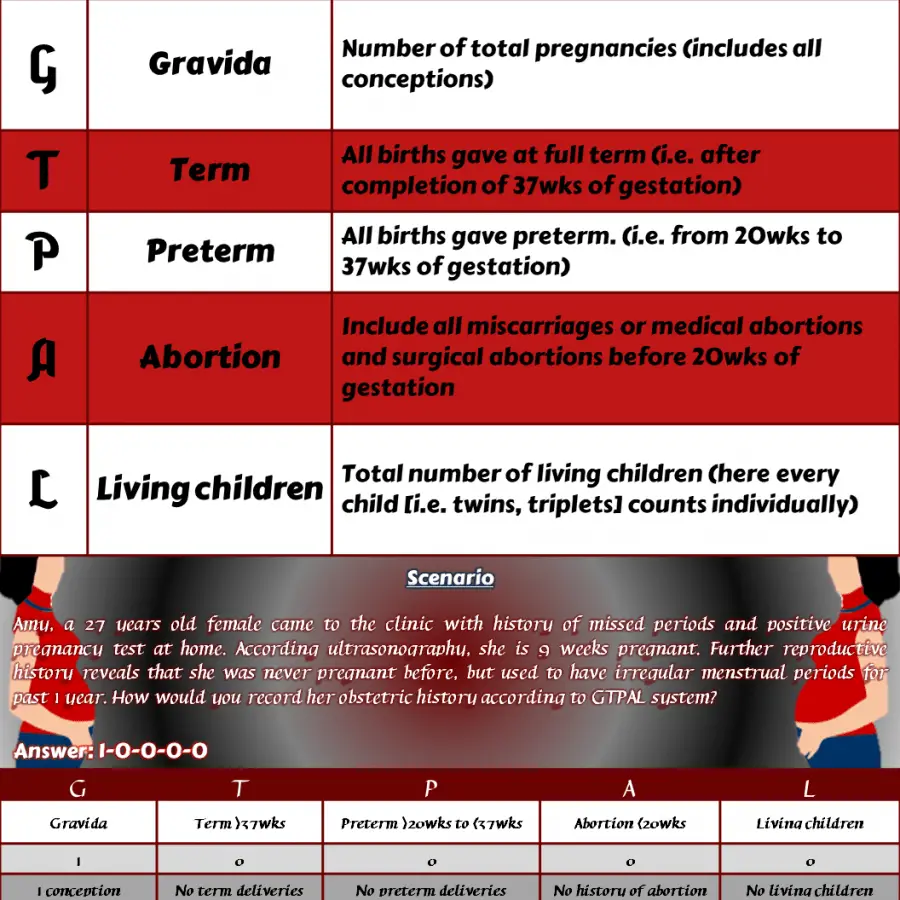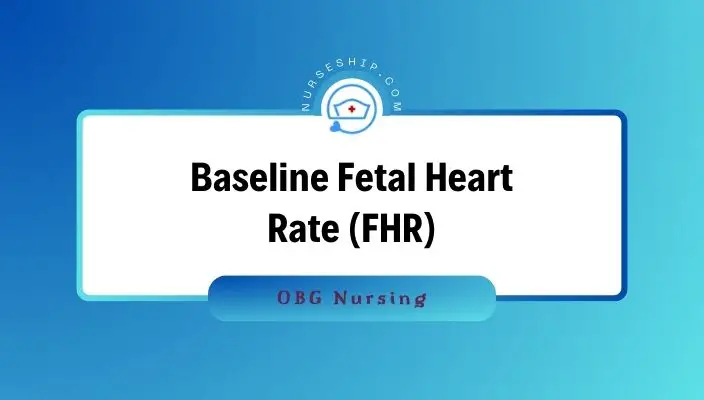What is Gravidity & Parity and GTPAL?
Check Out Our Maternity and Newborn Care Quiz Here.
Gravidity and parity, and GTPAL are systems used in health assessment to record woman’s obstetric history.
Gravidity and parity (G P) is a basic 2-digit system that only gives information about the number of pregnancies and births. While 5-digit GTPAL system provides more comprehensive data on obstetric history at a glance.
Details of a woman’s gravidity and parity are important. Because it gives critical information to the healthcare team to determine the level of risks for complications and plan individualized patient care.
For example, an elderly primigravida is at higher risk for several complications like spontaneous abortion, fetal distress preterm labor, and prolonged labor.
Here, we’ll discuss GP and GTPAL systems in detail with examples.
Gravidity and Parity (GP 2-Digit Recording System)
Gravidity and parity (GP) are a 2-digit system to record pregnancy and birth history of the women. This is more basic method of recording obstetric history which only include information about woman’s number of pregnancies and births.
Gravidity refers to the total number of pregnancies regardless of its outcome. A pregnancy can end in a live birth, miscarriage, premature birth (before 37 weeks of gestation), or an abortion.
The term Gravida refers to a woman who is currently pregnant.
For example, a woman who is currently pregnant has previous history of 2 miscarriages will be G3.
Parity refers to the number births after 20 weeks of gestation. When calculating parity also, you include all births beyond 20 weeks of gestation whether or not the baby born was alive.
The term Para just indicates the number of pregnancies carried beyond 20 weeks of gestation.
For example, P2 means the woman has given birth twice from two pregnancies carried beyond 20 weeks of gestation regardless of the baby born was alive or stillborn.
Also, it’s important to remember that gravida and para refers to pregnancies and not to babies. That way it will be easier to answer those confusing scenario questions.
For example, a woman who delivers a twin at 38 weeks of gestation in her first pregnancy is still a gravida one (G1) and para one (P1).
Challenge Yourself With Our Quizzes
GTPAL 5-Digit Recording System
GTPAL is the acronym for a 5-digit system of recording women’s obstetric history. It is just an extended version of the TPAL recording system with the addition of gravidity.
GTPAL provides quick overview of the person’s term and preterm pregnancies, abortions, and number of living children.
In the table below, you’ll see a description of the GTPAL acronym.
| Acronym GTPAL | Description |
| G | Gravida: number of total pregnancies (includes current pregnancy and all term, preterm, therapeutic abortions, and miscarriages) |
| T | Term: all births gave at full term (i.e.: after completion of 37wks of gestation) |
| P | Preterm: all births gave preterm. (i.e.: from 20wks to 37wks of gestation) |
| A | Abortion: include all miscarriages or medical abortions and surgical abortions before 20wks of gestation |
| L | Living children: total number of living children (here every child [i.e. twins, triplets] counts individually) |

Common Terminologies with Definition
| Gravida | Para |
|---|---|
| Nulli = none | |
| Nulligravida refers to a woman who has never been pregnant | Nullipara refers to a woman who has never given birth or who has never completed a pregnancy to the stage of viability (i.e: beyond 20wks of gestation) |
| Primi = First | |
| Primigravida refers to the first pregnancy of a woman | Primipara refers to a woman who has given birth once |
| Multi = 2 and/or more | |
| Multigravida refers to a woman who is now pregnant for the 2nd time or have been pregnant before regardless of the outcome of that pregnancy | Multipara refers to woman who has given birth 2 or more times |
| Grand Multi = 5 and more | |
| Grand multigravida refers to a woman who has been pregnant five times or more. | Grand multipara refers to a woman who has already given birth 5 times Great grand multipara refers to a woman who has given birth 7 times or more. |
| Parturient refers to women who is in labor. | Puerpera refers to women who has just given birth. |
Click HERE to learn more about Leopold Maneuvers
GP vs GTPAL Explained with Scenarios
Scenario 1: Gravida and Para for Twins
Sara is currently 38 weeks pregnant and has a history of 1 spontaneous abortion at 12 weeks of gestation and 1 normal vaginal delivery of twin boys at 37 weeks of gestation. So, how would you record her basic gravidity and parity using GP system?
Answer: According to GP system she is G3, P1.
Rationale: She conceived total 3 times (i.e.: 1 abortion, 1 normal delivery, and current pregnancy). So, she is gravida 3 (i.e.: G3).
But, she only carried 1 pregnancy to a stage of viability (beyond 20 weeks gestation) where she delivered twins. So, she is para 1 (i.e.: P1).
Scenario 2: GTPAL for Primigravida
Amy, a 27 years old female came to the clinic with history of missed periods and positive urine pregnancy test at home. According ultrasonography, she is 9 weeks pregnant. Further reproductive history reveals that she was never pregnant before, but used to have irregular menstrual periods for past 1 year. How would you record her obstetric history according to GTPAL system?
Answer: According to GTPAL system she is 1-0-0-0-0
Rationale: This is her very 1st conception. So, she is a primigravida.
| G | T | P | A | L |
| Gravida | Term >37wks | Preterm >20wks to <37wks | Abortion <20wks | Living children |
| 1 | 0 | 0 | 0 | 0 |
| 1 conception | No term deliveries | No preterm deliveries | No history of abortion | No living children |
Click Here To Test Your Maternal Nursing Knowledge With Our FREE NCLEX-Style Quiz
Scenario 3: GP and GTPAL for Preterm Twins
A woman who is 13 weeks pregnant, has a history of loss of 2 previous pregnancies at 10 weeks and 9 weeks of gestation respectively. She has 3 children, 1st child was delivered via normal vaginal delivery at 38 weeks. The second time she delivered twin girls at 36 weeks of gestation by LSCS due to PROM. What is her gravidity and parity according to the GP system and GTPAL?
Answer: According to GP system she is G5 P2 and according to GPTAL she is 5-1-1-2-3.
Rationale: Gravida includes all conceptions which includes present pregnancy and previous abortions as well. So, she is gravida 5. On the other hand, Para includes only previous pregnancies beyond the period of viability (i.e: pregnancies that carried beyond 20 weeks of gestation). So, she is para 2.
(Also note that number of babies born will be not included in gravidity and parity)
| G | T | P | A | L |
| Gravida | Term >37wks | Preterm >20wks to <37wks | Abortion <20wks | Living children |
| 5 | 1 | 1 | 2 | 3 |
| Current pregnancy + 2 miscarriages + 2 births = 5 | 1 delivery after 37wks of gestation | 1 delivery at 36wks of gestation | 2 miscarriages before 20wks of gestation | 3 children alive |
(Note that multiple or singleton pregnancies will be counted as 1 conception)
Scenario 4: GTPAL for Ectopic Pregnancy and Stillborn
Sandy just medically terminated her ectopic pregnancy at 10 weeks. This was her fifth pregnancy. Sadly, her first and fourth pregnancies also ended in a spontaneous loss at 16 and 24 weeks respectively. All her pregnancies have been singletons (one baby), one born living at 39 weeks and one stillbirth at 38 weeks. What is her gravidity and parity using GTPAL system?
Answer: GTPAL is 5-2-1-2-1.
| G | T | P | A | L |
| Gravida | Term >37wks | Preterm >20wks to <37wks | Abortion <20wks | Living children |
| 5 | 2 | 1 | 2 | 1 |
| 1 therapeutic abortion due ectopic pregnancy + 2 spontaneous loss + 2 births = 5 | Births at 39wks and 38wks. So, T=2 | 1 spontaneous loss at 24wks will be counted as P1 (Note that pregnancy was carried beyond 20wks). | 1 medical abortion at 10wks and 1 spontaneous at 16wks | 1 child alive |
Click HERE to learn more about Leopold Maneuvers
Scenario 5: GTPAL for Twins
A woman is currently pregnant with twins. She is in her first trimester now. Also, she has a history of one previous twin delivery at 38 weeks. That pregnancy was uneventful. Both kids are living and just turned 4. Using GTPAL acronym, how would you record this obstetric history?
Answer: GTPAL is 5-2-1-2-1.
| G | T | P | A | L |
| Gravida | Term >37wks | Preterm >20wks to <37wks | Abortion <20wks | Living children |
| 2 | 1 | 0 | 0 | 2 |
| Current pregnancy + previous 1 pregnancy = 2 (Note that each pregnancy is counted as one whether it’s a singleton (one fetus) or multiple(2 or more fetuses) | Delivered at 38wks. So, T=1 | No history of preterm birth | No history of abortion birth | 2 children alive (Note that here all living children will be included) |
Reference
Casanova, R., Chuang, A., Goepfert, A., Hueppchen, N., & Weiss, P. (2019). Beckmann and Ling’s Obstetrics and Gynecology (8th ed.). Wolters Kluwer.
Konar, H. (2015). DC Dutta’s textbook of obstetrics (8th ed). JP Brothers Medical.
O’Toole, M. (2013). Mosby’s medical dictionary (9th ed.). Elsevier.



